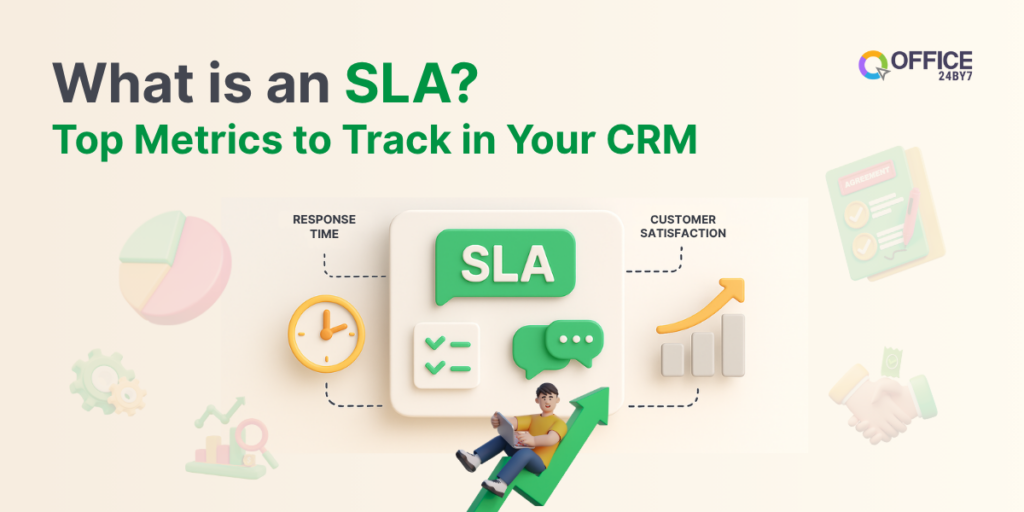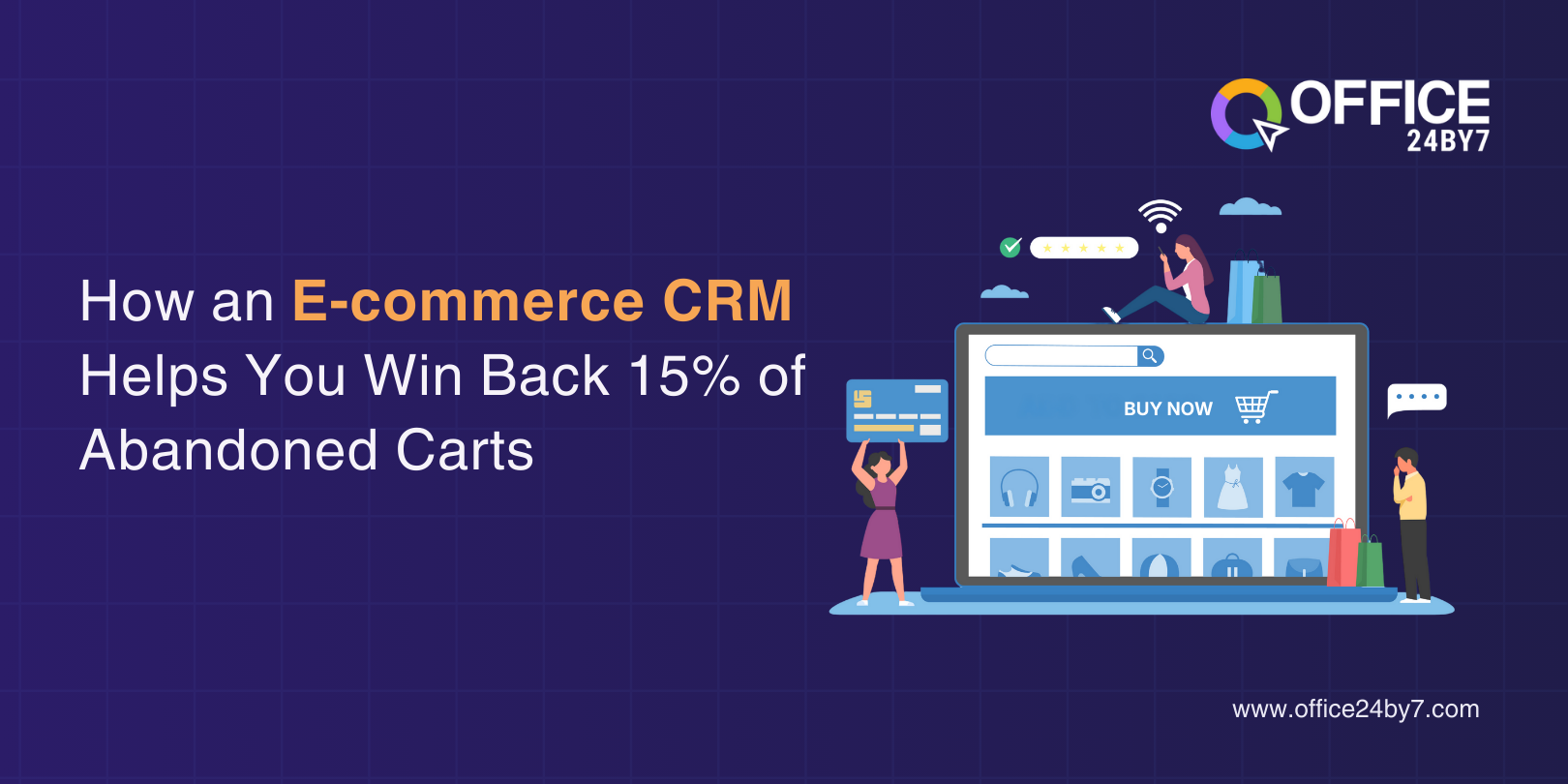
Not sure if this blog on SLA contains quality information?
Try our 1-minute short audio summary to decide. 🎧
Delayed responses, lost leads, and frustrated customers are all too common. You might have the best marketing campaigns, invest in cloud telephony systems, or run a top-notch Call Center Solution. Still, if your team doesn’t respond quickly and efficiently, those hard-won opportunities can vanish instantly. Every business, from startups to large enterprises, faces this challenge. The difference between companies that grow and those that struggle often comes down to how well they manage their promises, especially regarding response and resolution times. This is where Service Level Agreements (SLAs) and a powerful CRM Suite become your secret weapons.
Why Response Time and SLA Tracking Matter More Than Ever
An SLA is more than just a technical term or a contract clause. It’s a simple yet powerful promise, a handshake between your team and your customers, or even between different teams inside your company. When your team promises to respond in two hours or resolve a ticket in 24 hours, you set expectations and build trust. But as your business grows, keeping these promises gets harder. That’s why modern CRM platforms, with features like automation, real-time dashboards, and instant alerts, are essential. They help you enforce SLAs, keep your team accountable, and ensure no lead or customer ever feels ignored.
Let’s find out what SLAs are, why they matter, and how you use your CRM Suite to track the right metrics and turn service commitments into a true business advantage.
- Why Response Time and SLA Tracking Matter More Than Ever
- What is an SLA in CRM?
- SLA Meaning and Purpose
- How SLAs Work Inside a CRM?
- SLA Process in a CRM
- Why Tracking SLA Metrics is Crucial
- From Compliance to Customer Experience
- Role of CRM in SLA Tracking
- Top SLA Metrics You Should Track in Your CRM
- 1. First Response Time
- 2. Resolution Time / Closure Time
- 3. SLA Compliance Rate
- 4. Breach Rate
- 5. Average Handling Time (AHT)
- 6. Escalation Rate
- Real-World Use Cases: SLAs in Action
- Common Pitfalls in SLA Management (And How to Avoid Them)
- Conclusion (Turn SLAs Into a Competitive Advantage)
What is an SLA in CRM?
Every business wants to deliver on its promises, but as your team and customer base grow, it’s easy for things to slip through the cracks. You might have a flood of leads from your latest SMS broadcasting service or a rush of support tickets after a new product launch. When teams lack clear rules and systems, they lose requests, delay responses, and disappoint customers. This is where SLAs come in, especially when managed through a CRM. They help you set clear expectations, deliver better service, and keep your team accountable.
SLA Meaning and Purpose
A Service Level Agreement (SLA) is a clear, measurable commitment about how quickly and how well your team will respond to leads, tickets, or service requests. In the context of CRM, SLAs are often internal. For example, your inside sales team might agree to follow up on every new lead within two hours, while your support team promises to resolve high-priority tickets within 24 hours. These agreements aren’t just about speed; they’re about building trust, setting expectations, and creating a culture of accountability.
SLAs are especially important in industries where time is money and customer expectations are high. In IT, telecom, SaaS, logistics, and BPO, a missed SLA can mean more than just a disappointed customer; it can lead to lost revenue, damaged reputations, and even contract penalties. In these industries, SLAs are not just a best practice; they’re often a non-negotiable part of doing business.
But SLAs aren’t limited to external promises. They’re just as valuable for internal communication and collaboration. For example, your marketing team might set an SLA for how quickly sales should follow up on leads generated from a voice broadcasting service. Or your support team might have an SLA for how fast they escalate complex tickets to technical experts. These internal SLAs keep everyone aligned and ensure a smooth customer journey from the first touchpoint to final resolution.
How SLAs Work Inside a CRM?
So, how do SLAs work inside a CRM? Modern CRM platforms like Office24by7 have transformed SLA management from a manual, error-prone process into a streamlined, automated system. Instead of relying on sticky notes, spreadsheets, or memory, you can configure SLAs for every stage of your sales, support, or service process.
For example, you can set different rules for different types of leads, tickets, or requests. Maybe leads from your latest email marketing campaign need a callback within 15 minutes, while standard inquiries have a two-hour window. Your team can prioritize support tickets by customer tier, urgency, or channel, so VIP callers through your IVR system get priority service. The CRM logs every interaction, starts timers the moment it creates a lead or ticket, and issues alerts and reminders to keep the team on track.
With features like click-to-call, missed call tracking, and WhatsApp bots, CRM platforms make it easy to respond quickly and consistently. For example, if a customer requests OTP authentication or submits support feedback, the CRM can trigger an automatic response and start the SLA timer. This level of automation helps your team track, measure, and manage every interaction, regardless of workload.
SLA Process in a CRM
A typical SLA process using a CRM like Office24by7 is something like this: a new lead comes in through a missed call or a WhatsApp Bot. The CRM instantly assigns the lead to the right team member and starts the SLA timer. If your team doesn’t contact the lead in time, the CRM alerts the responsible person. If the deadline passes, it can automatically escalate the lead to a supervisor or trigger a workflow to reassign it. This level of automation enables your team to handle every lead and request promptly, no matter how busy they are.
You can also customize SLAs based on lead source, customer tier, or priority. High-value deals, enterprise sales, or urgent support tickets can have tighter SLAs, while routine tasks follow standard timelines. This approach allows you to deliver truly personalized service, ensuring that VIP customers and hot leads from your omnichannel marketing efforts receive faster attention, while your team isn’t overwhelmed by unrealistic timelines for every task.
For example, Office24by7 lets you set SLA rules for each stage, like requiring your team to contact a new lead within 30 minutes. The system uses timers, countdowns, and breach alerts to keep everyone on track. If the team doesn’t complete a task on time, the CRM escalates it automatically.
Why Tracking SLA Metrics is Crucial
Tracking SLAs isn’t just about following rules; it’s about building a business that customers trust and rely on. By monitoring SLA metrics, you can spot problems early, fix them quickly, and keep your team accountable. Here’s why it matters for every growing business.
From Compliance to Customer Experience
Meeting your SLAs means fewer dropped leads, faster resolutions, and happier clients. When you consistently deliver on your promises, customers notice and trust you more. Internally, SLAs build accountability and help teams work better together. In B2B setups, missed SLAs can even lead to lost revenue or contract penalties, making it crucial to stay on top of these agreements.
But the impact goes beyond compliance. When you meet your SLAs, you create a positive customer experience. Customers know what to expect, and they feel valued when you deliver on your promises. This builds loyalty and increases the chances of repeat business and referrals. On the other hand, missed SLAs can lead to frustration, negative reviews, and lost opportunities.
SLAs also help you identify areas for improvement. If you notice that certain types of requests consistently breach their SLAs, you can dig deeper to find the root cause, whether it’s a staffing issue, a process bottleneck, or a technology gap. By tracking SLA metrics, you turn data into action and drive continuous improvement across your organization.
Role of CRM in SLA Tracking
A CRM Suite is your best tool for SLA tracking. Real-time dashboards let you see how your team is performing at a glance. Automated alerts warn you before a breach happens, so you can act fast. And with workflow automation, the CRM reassigns or escalates delayed tasks so your team never misses a commitment.
For example, if a support ticket is close to breaching its SLA, the CRM can send an instant alert to the assigned agent and their manager. If your team doesn’t resolve the issue in time, the system escalates the ticket to a higher support tier automatically. This proactive approach helps you catch problems before they impact the customer.
The best sales automation CRM platforms also provide detailed reports and analytics on SLA performance. You can track compliance rates, breach rates, and average handling times for different teams, channels, or customer segments. This visibility helps you make data-driven decisions, allocate resources more effectively, and optimize your processes for better results.
CRM Suites equipped with contact, lead, and deal management help your team track every interaction and capture every opportunity. Whether you’re managing inside sales, enterprise sales, or field sales, your CRM gives you the tools you need to deliver on your SLAs and exceed customer expectations.
Feel the power of a CRM Software!

Top SLA Metrics You Should Track in Your CRM
Knowing which SLA metrics to track is key to improving your service and keeping customers happy. Each metric tells you something important about your team’s performance and customer experience.
1. First Response Time
First Response Time measures how long it takes for your team to reply to a new ticket or lead. Quick responses are a major driver of customer satisfaction; delays can break deals before they even start. This metric helps you understand how quickly you’re engaging new opportunities.
For example, when a lead submits a click-to-call service request, the CRM immediately starts the clock. If your team responds within minutes, the customer feels valued and is more likely to convert. However, if your team delays the response, the lead may lose interest or pick a competitor.
Tracking First Response Time helps you identify gaps in your process and set realistic expectations for your team. It also allows you to benchmark your performance against industry standards and strive for continuous improvement.
2. Resolution Time / Closure Time
Your team calculates Resolution Time, or Closure Time, by tracking how long it takes to fully resolve an issue or close a lead. This metric reflects how efficient your team is and helps you plan resources better. The faster you can solve problems or close deals, the more productive and profitable your business will be.
For support teams, Resolution Time is a key indicator of service quality. Customers want their issues resolved quickly, and long wait times can lead to frustration. For sales teams, Closure Time measures how long it takes to move a lead from initial contact to a closed deal. Shorter closure times mean faster revenue and happier customers.
By tracking Resolution Time, you can identify blockages in your process and implement changes to improve efficiency. You can set different SLAs for each request type so your team prioritizes and resolves urgent issues faster.
3. SLA Compliance Rate
SLA Compliance Rate is the percentage of tasks or tickets resolved within the agreed-upon timelines. It’s a clear indicator of your team’s reliability, especially when you’re dealing with high volumes of requests. High compliance rates show customers they can count on you.
This metric is especially important for businesses that handle large numbers of leads or support tickets. If your compliance rate is high, it means your team is consistently meeting its commitments and delivering on customer expectations. If it’s low, it’s a sign that something needs to change, whether it’s staffing, training, or process improvements.
Sales CRM platforms make it easy to track compliance rates for different teams, channels, or customer segments. You can set targets, monitor progress, and take action when performance falls short. This level of visibility helps you drive accountability and continuous improvement across your organization.
4. Breach Rate
Breach Rate shows the number or percentage of SLA violations over time. Tracking this helps you find bottlenecks or staffing issues that need attention before they hurt your business. A high breach rate is a warning sign that something in your process needs to be fixed.
For example, if you notice that a particular team or channel has a high breach rate, you can investigate further to find the root cause. Maybe the team is understaffed, or maybe the process is too complex. By identifying and addressing these issues, you can reduce breaches and improve overall performance.
CRM platforms provide detailed reports on breach rates, allowing you to track trends over time and measure the impact of process changes. This data-driven approach helps you make informed decisions and prioritize improvements that have the greatest impact on customer experience.
5. Average Handling Time (AHT)
Average Handling Time (AHT) is the time spent actively working on an issue or a lead. It helps you balance workloads and set realistic SLAs for your team. If AHT is too high, you might need more training, better tools, or additional staff.
AHT is especially important for support teams using cloud telephony or IVR systems, where efficiency is key to keeping customers happy. By tracking AHT, you can identify areas where your team is spending too much time and implement changes to streamline processes. For sales teams, AHT can help you understand how much effort is required to close a deal and allocate resources more effectively.
CRM platforms make it easy to track AHT for different teams, channels, or customer segments. You can set targets, monitor progress, and take action when performance falls short. This level of visibility, combined with features like mobile CRM and activity tracking, helps you drive efficiency and continuous improvement across your organization.
6. Escalation Rate
Escalation Rate measures how often tasks are escalated because they’re at risk of missing their SLA. High escalation rates can signal deeper process issues that need fixing. By monitoring this metric, you can spot trouble before it turns into a crisis.
For example, if a particular type of request is frequently escalated, it may indicate that the initial team lacks the skills or resources to resolve it. By identifying these patterns, you can provide additional training, adjust staffing levels, or streamline processes to reduce escalations and improve overall performance.
CRM platforms provide detailed reports on escalation rates, allowing you to track trends over time and measure the impact of process changes. This data-driven approach, supported by tools like lead tracker and ticketing management software, helps you make informed decisions and prioritize improvements that have the greatest impact on customer experience.
Real-World Use Cases: SLAs in Action
SLAs aren’t just theory; they make a real difference in daily business. Here are some practical examples of how companies use SLAs to improve results.
In B2B sales, SLAs are used for proposal follow-ups within the sales CRM. For instance, an inside sales team uses Mobile CRM to ensure every proposal gets a response within 24 hours. If a lead is not contacted in time, the CRM escalates the task, and managers can step in before the opportunity is lost.
In the support department, SLAs are critical for high-priority tickets. A call center solution might require urgent issues to be resolved within two hours. The CRM tracks each ticket, sends reminders as deadlines approach, and escalates unresolved tickets automatically. This ensures that customers never feel ignored, and your support team stays focused on what matters most, using features like missed call services and support feedback surveys.
Marketing teams can also benefit from SLAs. Drip marketing campaigns, for example, rely on timely follow-ups. Every new lead generated by outbound marketing or omnichannel marketing efforts is assigned an SLA for follow-up, ensuring no prospect is left behind. Features like lead tracker and email marketing builder make it easy to automate these processes and monitor compliance.
Common Pitfalls in SLA Management (And How to Avoid Them)
Even with the best tools, managing SLAs can go wrong. One common mistake is using generic SLA rules that aren’t tied to customer tiers or specific channels. Not all customers or leads are equal, and a one-size-fits-all approach can lead to missed opportunities or wasted resources. The solution is to tailor SLAs by segment, channel, or urgency, using your CRM Suite’s customization features.
Another challenge is the lack of alerts or dashboards to track near-breaches. Without real-time visibility, it’s easy for tasks to slip through the cracks. Automated and manual reports, as well as real-time dashboards, can help your team stay on top of every commitment.
Rigid SLAs that don’t account for priority or volume can also cause problems, especially during peak periods. Giving your team SLA visibility from their dashboard and allowing for dynamic adjustments ensures that you can respond to changing conditions without sacrificing service quality. Tools like WhatsApp bot integration and call patching solutions can further streamline communication and response times.
To avoid these pitfalls, it’s important to customize SLA rules, audit breaches monthly, and empower teams with clear visibility and actionable insights. Office24by7, for instance, offers solutions for each of these challenges, letting you tailor SLA rules, generate automated reports, and give your team the tools they need to succeed, whether in support, sales, or marketing.
Conclusion (Turn SLAs Into a Competitive Advantage)
Speed, reliability, and customer trust are everything in business. Service Level Agreements (SLAs) aren’t just about meeting deadlines; they’re about showing your customers and your team that you keep your promises. Understanding and tracking your SLA metrics is the first step to delivering better service and building trust with your customers. With the right CRM, SLA tracking becomes proactive, not reactive. Now it’s time to review your current SLA settings, optimize your workflows with automation, and empower your team to deliver on every promise.
Want better SLA compliance? Discover how Office24by7 can automate, track, and improve your service benchmarks, so you never miss another opportunity or let down a customer.
Call us at +91-7097171717 or email sales@office24by7.com and transform your growth strategy today!





